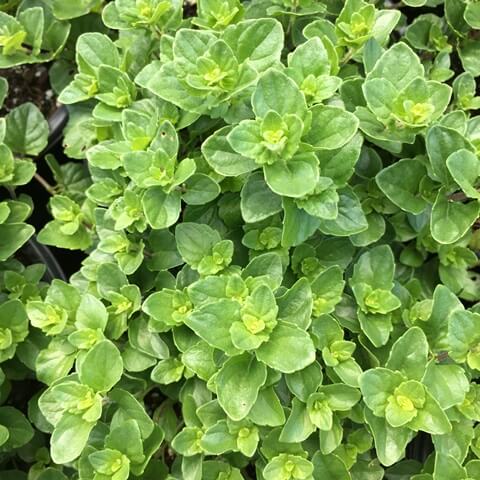
Boething Treeland Farms grows over 1,000 varieties of trees, shrubs, perennials and specialty plants on 10 California nurseries to serve the wholesale landscape and nursery industries throughout the Western United States and beyond.
Plant Type: Ground Covers
Evergreen-Deciduous: Evergreen
Overall Mature Size: Small
Also Grown As: Bush
Mature Height & Spread: 6" x 3'
Natural Growth Habit: Spreading
Native To: California, Pacific Northwest
Exposure: Partial Shade
Water: Medium Water, Low Water
Flower Color: White
Bloom Time: Spring, Summer
Special Features: Deer Resistant / Drought Resistant / Edible / Fragrant
Container Sizes: #1
Sunset Garden Zones: 4-9, 14-24
Minimum USDA Hardiness Zone: 7-10
Named Yerba Buena, or ‘good herb (hierba)’ in Spanish, Satureja douglasii is ‘buena’ for many reasons. Drought, shade, sand and clay tolerant, this beautiful green ground cover will root and grow in a variety of environments. But not to worry: this well-behaved herb roots along its stems and grows a modest 6” tall and 3’ wide. Previously known as Clinopodium douglasii, Satureja is found in woodland areas, particularly along the coast, where it is seen under Oaks, Redwoods, and Madrones. When crushed, the leaves release a pleasing, minty scent. Indigenous peoples of California used the leaves in a tea to aid sleep, digestive distress and arthritis. These days, you may see it muddled in a refreshing cocktail. Use Yerba Buena in rockeries, under tree canopies, or trailing over wall edges and containers.
Named Yerba Buena, or ‘good herb (hierba)’ in Spanish, Satureja douglasii is ‘buena’ for many reasons. Drought, shade, sand and clay tolerant, this beautiful green ground cover will root and grow in a variety of environments. But not to worry: this well-behaved herb roots along its stems and grows a modest 6” tall and 3’ wide. Previously known as Clinopodium douglasii, Satureja is found in woodland areas, particularly along the coast, where it is seen under Oaks, Redwoods, and Madrones. When crushed, the leaves release a pleasing, minty scent. Indigenous peoples of California used the leaves in a tea to aid sleep, digestive distress and arthritis. These days, you may see it muddled in a refreshing cocktail. Use Yerba Buena in rockeries, under tree canopies, or trailing over wall edges and containers.